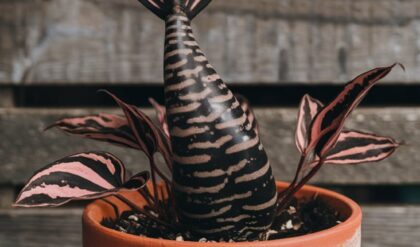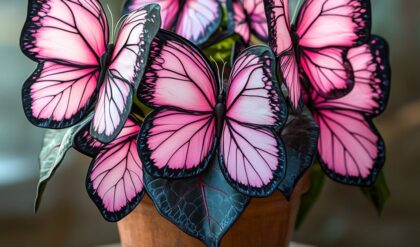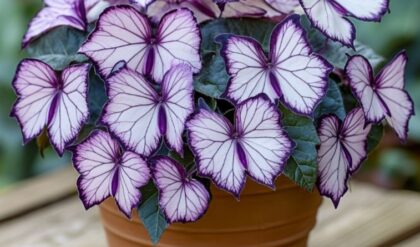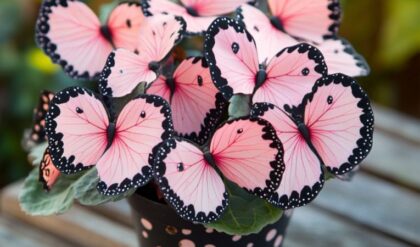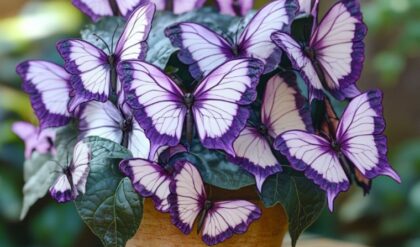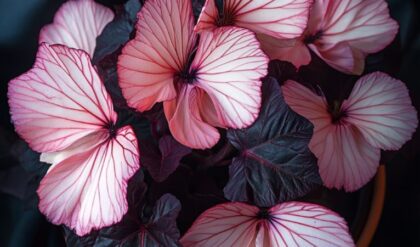In the vast realm of botanical wonders, few specimens capture the imagination quite like the Moonlight Butterfly Plant. This captivating begonia, scientifically known as Begonia ‘Moonlight Butterfly’, stands as a testament to nature’s artistry and the endless fascination it holds for plant enthusiasts worldwide. With its striking foliage reminiscent of delicate butterfly wings and a palette that seems to have been painted by moonlight itself, this extraordinary plant has rightfully earned its place as a prized possession in both indoor and outdoor gardens. Join us as we embark on an in-depth exploration of this horticultural marvel, uncovering its secrets, care requirements, and the profound impact it has on those fortunate enough to cultivate it.
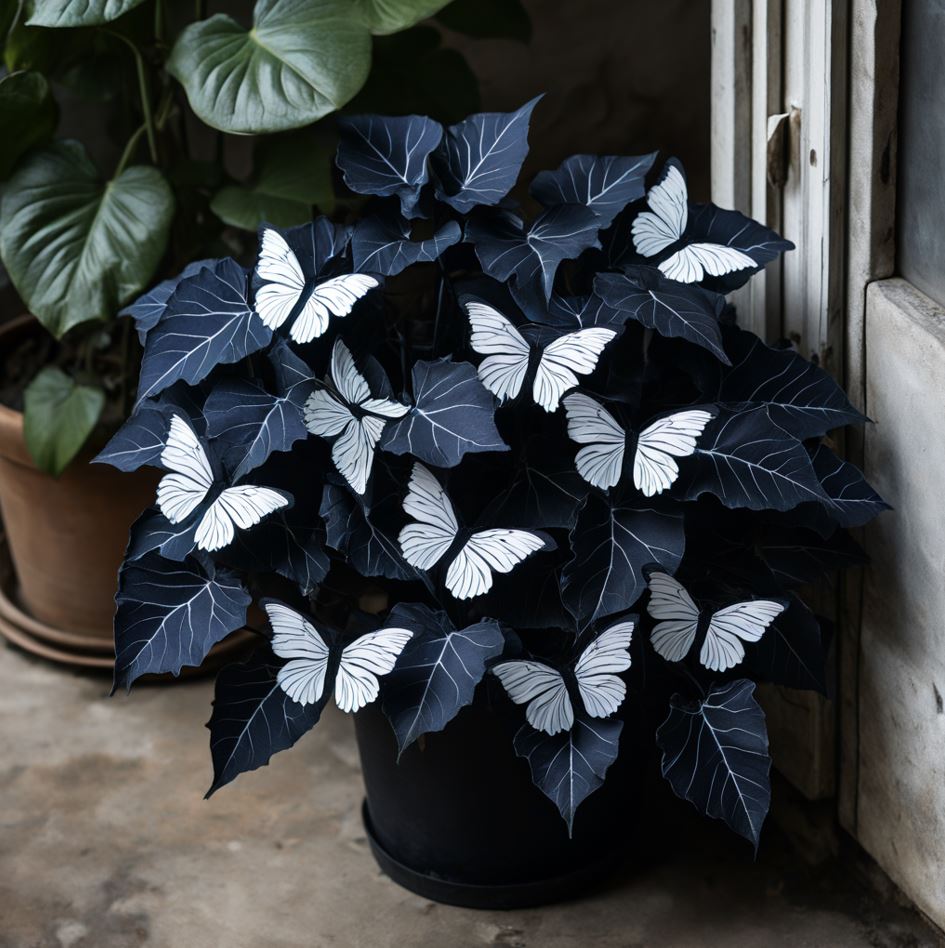
The Aesthetic Allure of the Moonlight Butterfly Plant
The Moonlight Butterfly Plant is a visual symphony, orchestrating a delicate balance between light and shadow, color and texture. Its aesthetic appeal goes far beyond mere ornamental value, often evoking a sense of wonder and tranquility in those who behold it.
The Mesmerizing Foliage
The leaves of the Moonlight Butterfly Plant are nothing short of a natural masterpiece. Dark, velvety surfaces are intricately adorned with silvery-white veins that create an ethereal, almost luminescent effect. This striking contrast is reminiscent of moonlight filtering through a dense forest canopy, casting delicate patterns on the forest floor.
The leaf structure itself is a marvel of natural engineering. Each leaf is asymmetrical, with one side larger than the other, creating a dynamic and visually interesting profile. The edges of the leaves are often scalloped or serrated, adding another layer of texture to the overall appearance.
As the plant matures, the overlapping leaves create a lush, multi-dimensional display. New growth often emerges with a reddish tint, gradually darkening to deep green or near-black as it matures. This ever-changing palette ensures that the plant remains a constantly evolving work of art.
The Play of Light and Shadow
One of the most captivating aspects of the Moonlight Butterfly Plant is its interaction with light. In bright, indirect sunlight, the silvery veins seem to glow, creating an almost holographic effect. As the day progresses and light conditions change, the plant takes on different personas.
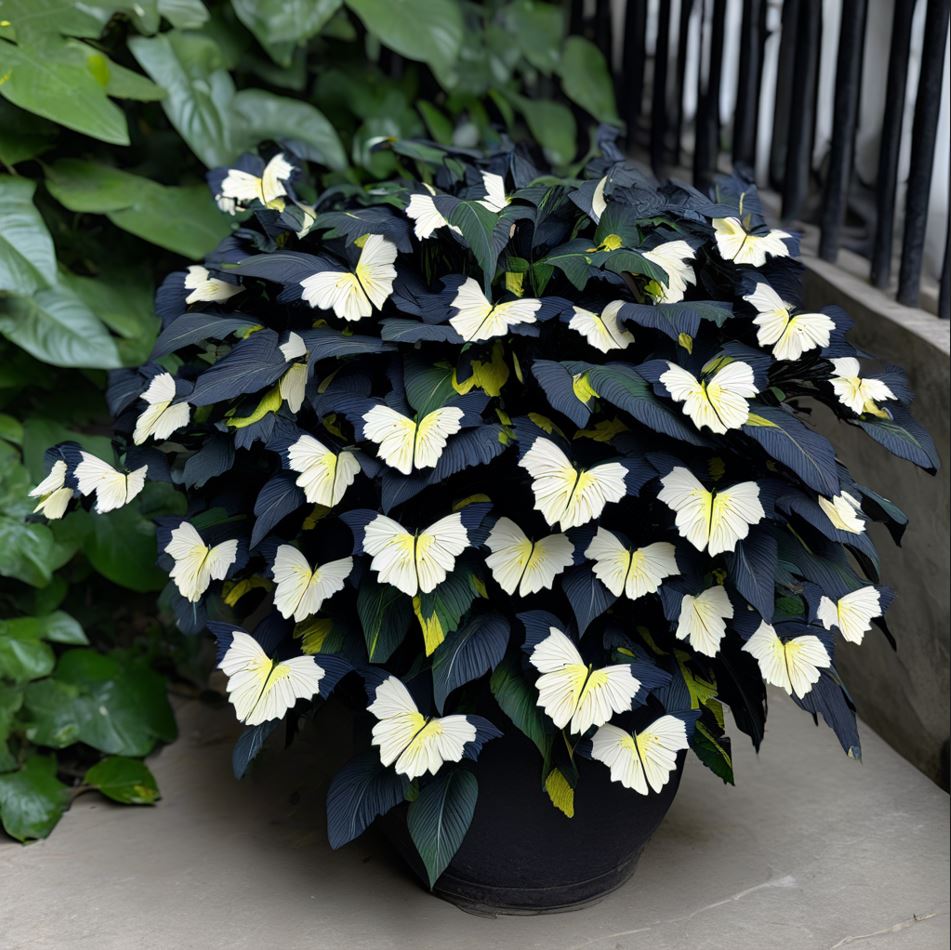
During the morning hours, when soft light filters through, the leaves appear to shimmer with an inner radiance. At midday, under stronger light, the contrast between the dark leaf surface and light veins becomes more pronounced, showcasing the intricate patterns in all their glory.
Perhaps most enchanting is the plant’s appearance in low light or evening conditions. Here, it truly lives up to its name, with the pale veins seeming to capture and reflect what little light is available, creating a ghostly, moonlit effect that can transform an entire room.
The Tactile Experience
While the visual appeal of the Moonlight Butterfly Plant is undeniable, its tactile qualities are equally impressive. The leaves have a velvety texture that invites touch, adding a sensory dimension to the plant’s allure.
Running a finger along the surface of a leaf reveals a soft, almost plush feeling, reminiscent of the finest velvet. This texture not only enhances the plant’s visual depth but also creates a connection between plant and caretaker, encouraging interaction and fostering a deeper appreciation for this living work of art.
Cultivation and Care: Nurturing Your Moonlight Butterfly
Successfully growing and maintaining a Moonlight Butterfly Plant requires a delicate balance of various factors. Understanding and providing for its specific needs will ensure that your plant not only survives but thrives, rewarding you with its stunning beauty for years to come.
Creating the Ideal Environment
The Moonlight Butterfly Plant, like many begonias, originates from tropical and subtropical regions. As such, it thrives in conditions that mimic its natural habitat. Creating a microclimate that balances humidity, temperature, and light is crucial for the plant’s well-being.
Humidity is perhaps one of the most critical factors. These plants prefer a humid environment, ideally between 50-70% relative humidity. In drier climates or during winter months when indoor heating can dry out the air, consider using a humidifier or placing the plant on a pebble tray filled with water to increase local humidity.
Temperature is another crucial element. The Moonlight Butterfly Plant prefers temperatures between 60-75°F (15-24°C). It’s important to protect the plant from extreme temperature fluctuations and cold drafts, which can cause leaf drop and other stress-related issues.
Light requirements for this begonia are specific. It thrives in bright, indirect light but can suffer from leaf burn if exposed to direct sunlight, especially during the hottest parts of the day. An east-facing window that receives morning sun and filtered light throughout the day is often ideal. For those in less ideal lighting situations, grow lights can be an excellent solution to ensure the plant receives adequate light without the risk of sun damage.
Soil and Watering Techniques
The right soil mix is fundamental for the health of your Moonlight Butterfly Plant. A well-draining, slightly acidic soil is ideal. A mixture of peat moss, perlite, and regular potting soil in equal parts can provide the perfect growing medium. This combination ensures good aeration and drainage while retaining enough moisture to keep the roots happy.
Watering is a delicate balance with this plant. While it enjoys consistent moisture, it’s susceptible to root rot if overwatered. The key is to keep the soil lightly moist but never soggy. Water thoroughly when the top inch of soil feels dry to the touch, allowing excess water to drain freely from the pot.
During the growing season (spring and summer), you may need to water more frequently. In winter, as growth slows, reduce watering accordingly. Always use room temperature water to avoid shocking the plant’s sensitive root system.
Feeding and Fertilization
To maintain the lush foliage and vibrant colors of your Moonlight Butterfly Plant, regular fertilization is essential. During the growing season, feed your plant every 2-4 weeks with a balanced, water-soluble fertilizer diluted to half strength.
Be cautious not to over-fertilize, as this can lead to salt buildup in the soil and damage the plant’s delicate root system. If you notice the leaf edges turning brown or crispy, this could be a sign of fertilizer burn, and you should flush the soil with plain water and reduce feeding frequency.
In autumn and winter, as growth slows, reduce or stop fertilization altogether to allow the plant a period of rest. This mimics the natural growth cycle and helps prevent nutrient buildup in the soil.
Pruning and Maintenance
Regular pruning is crucial for maintaining the shape and health of your Moonlight Butterfly Plant. Remove any dead, damaged, or yellowing leaves promptly to encourage new growth and prevent potential disease spread.
To promote bushier growth, pinch back the growing tips of stems. This encourages branching and results in a fuller, more compact plant. Always use clean, sharp scissors or pruning shears to make clean cuts and minimize the risk of infection.
Dusting the leaves regularly with a soft, damp cloth not only keeps your plant looking its best but also helps it photosynthesize more efficiently. Be gentle when handling the leaves to avoid damaging their delicate surface.
The Cultural Significance and Impact of the Moonlight Butterfly Plant
Beyond its undeniable beauty, the Moonlight Butterfly Plant has woven itself into the fabric of horticultural culture and community, becoming more than just a decorative element but a symbol of connection, creativity, and the human relationship with nature.
A Community United by Beauty
The Moonlight Butterfly Plant has fostered a vibrant community of enthusiasts, collectors, and growers who share a passion for this unique specimen. Online forums, social media groups, and local gardening clubs have become hubs of activity where knowledge is shared, experiences are exchanged, and friendships are formed.
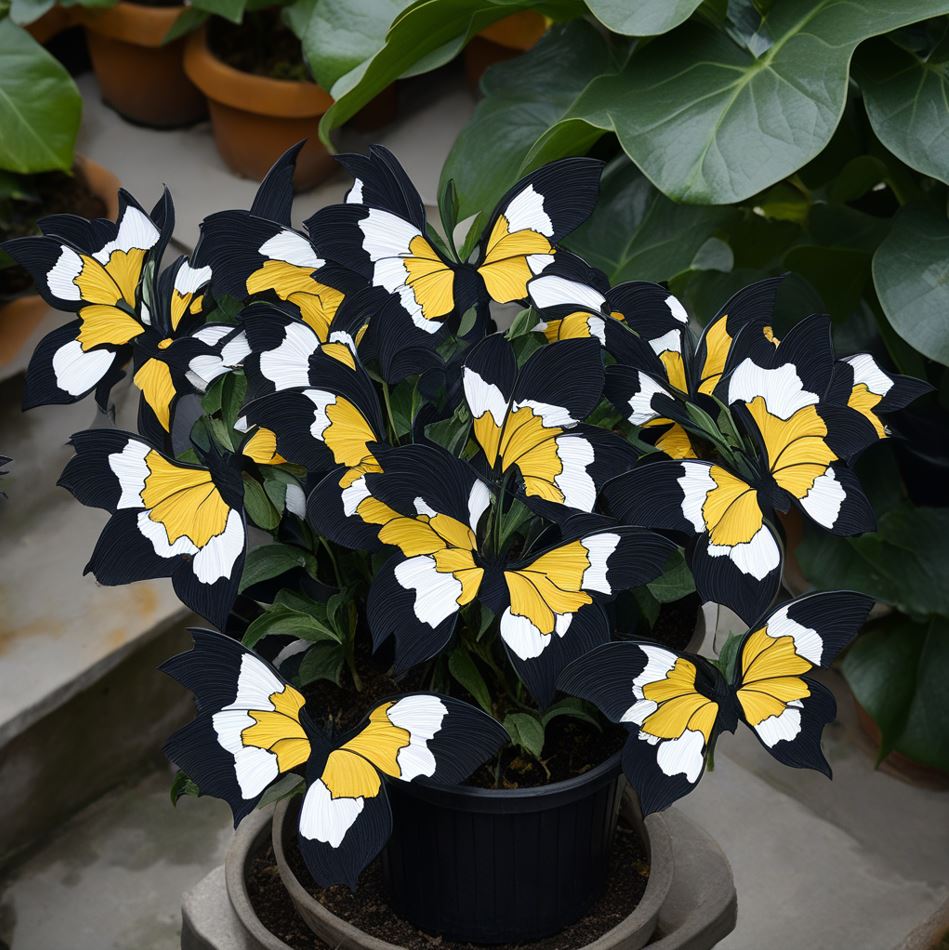
These communities serve as invaluable resources for both novice and experienced growers. Members often share tips on overcoming common cultivation challenges, celebrate each other’s successes, and provide support during setbacks. The shared experience of nurturing these plants creates a sense of camaraderie that transcends geographical boundaries.
Moreover, the plant’s striking appearance has made it a favorite subject for photographers and artists. Social media platforms are awash with stunning images of Moonlight Butterfly Plants, each capture highlighting a different aspect of its beauty. This visual celebration not only spreads awareness about the plant but also inspires others to explore the world of exotic houseplants.
Therapeutic Benefits and Mindfulness
In an increasingly fast-paced and digitally dominated world, the Moonlight Butterfly Plant offers a tangible connection to nature. The act of caring for this plant can be a form of mindfulness practice, encouraging individuals to slow down, observe, and engage with the natural world on a daily basis.
Horticultural therapy has long recognized the mental health benefits of plant care. The Moonlight Butterfly Plant, with its unique appearance and care requirements, provides an excellent subject for this practice. The routine of checking soil moisture, observing new growth, and tending to its needs can be a grounding and meditative experience.
Furthermore, the plant’s nocturnal aesthetic qualities make it particularly suited for creating calming, retreat-like spaces within the home. Many enthusiasts report feeling a sense of tranquility and wonder when observing their Moonlight Butterfly Plants in low light conditions, likening the experience to a mini escape into a magical forest.
Inspiration for Design and Creativity
The distinctive appearance of the Moonlight Butterfly Plant has made it a muse for various creative endeavors. Interior designers have embraced its dramatic foliage as a focal point in room designs, using its unique coloration as inspiration for entire color schemes.
In the world of fashion and textiles, the plant’s intricate vein patterns have inspired prints and embroidery designs. Its color palette of deep greens, purples, and silvery whites has influenced everything from haute couture to home decor.
Even in the realm of technology, the Moonlight Butterfly Plant has left its mark. Its bioluminescent-like qualities have inspired designs for energy-efficient lighting solutions and display technologies that mimic the plant’s ability to create striking visual effects with minimal light.
Environmental Awareness and Conservation
The popularity of the Moonlight Butterfly Plant has also served as a gateway for many to develop a deeper interest in plant biodiversity and conservation. As enthusiasts learn about the specific needs and origins of this plant, they often become more aware of the delicate ecosystems that produce such unique specimens.
This increased awareness has led to greater support for conservation efforts, not just for begonias but for tropical and subtropical habitats in general. Many Moonlight Butterfly Plant enthusiasts have become advocates for sustainable plant collection practices and habitat preservation.
Additionally, the plant’s ability to thrive indoors has made it a poster child for the benefits of bringing nature into urban environments. It demonstrates how even those with limited outdoor space can create green sanctuaries within their homes, promoting the idea of urban greening on a personal scale.
Conclusion: The Enduring Charm of the Moonlight Butterfly Plant
As we conclude our journey through the enchanting world of the Moonlight Butterfly Plant, it’s clear that this botanical wonder is far more than just a pretty leaf. From its mesmerizing aesthetics to its role in fostering community and creativity, this remarkable begonia has carved out a unique place in the hearts of plant enthusiasts and in the broader cultural landscape.
The Moonlight Butterfly Plant stands as a testament to nature’s artistry, challenging our perceptions of what a houseplant can be. Its care requirements teach us patience and attention to detail, while its beauty rewards us with a daily dose of wonder. In cultivating this plant, we not only grow a stunning specimen but also nurture our connection to the natural world and to each other.
Whether you’re a seasoned horticulturist or a curious newcomer to the world of plants, the Moonlight Butterfly offers an invitation to explore, learn, and marvel. It reminds us that even in the confines of our homes, we can create spaces of magic and tranquility, bringing a piece of the moonlit forest into our daily lives.
As we continue to navigate an increasingly digital and fast-paced world, plants like the Moonlight Butterfly serve as anchors, grounding us in the timeless rhythms of nature. They inspire us to slow down, observe, and appreciate the intricate beauty that surrounds us. In the end, perhaps the true magic of the Moonlight Butterfly Plant lies not just in its striking appearance, but in its ability to transform our spaces and ourselves, one leaf at a time.
